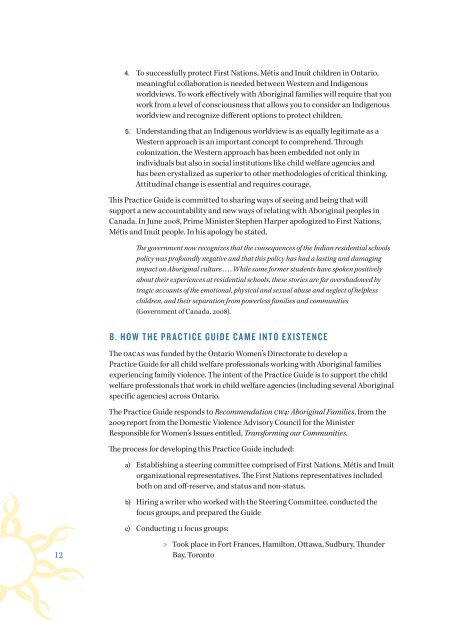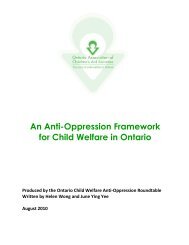English - Ontario Association of Children's Aid Societies
English - Ontario Association of Children's Aid Societies
English - Ontario Association of Children's Aid Societies
You also want an ePaper? Increase the reach of your titles
YUMPU automatically turns print PDFs into web optimized ePapers that Google loves.
4. To successfully protect First Nations, Métis and Inuit children in <strong>Ontario</strong>,<br />
meaningful collaboration is needed between Western and Indigenous<br />
worldviews. To work effectively with Aboriginal families will require that you<br />
work from a level <strong>of</strong> consciousness that allows you to consider an Indigenous<br />
worldview and recognize different options to protect children.<br />
5. Understanding that an Indigenous worldview is as equally legitimate as a<br />
Western approach is an important concept to comprehend. Through<br />
colonization, the Western approach has been embedded not only in<br />
individuals but also in social institutions like child welfare agencies and<br />
has been crystalized as superior to other methodologies <strong>of</strong> critical thinking.<br />
Attitudinal change is essential and requires courage.<br />
This Practice Guide is committed to sharing ways <strong>of</strong> seeing and being that will<br />
support a new accountability and new ways <strong>of</strong> relating with Aboriginal peoples in<br />
Canada. In June 2008, Prime Minister Stephen Harper apologized to First Nations,<br />
Métis and Inuit people. In his apology he stated,<br />
The government now recognizes that the consequences <strong>of</strong> the Indian residential schools<br />
policy was pr<strong>of</strong>oundly negative and that this policy has had a lasting and damaging<br />
impact on Aboriginal culture . . . . While some former students have spoken positively<br />
about their experiences at residential schools, these stories are far overshadowed by<br />
tragic accounts <strong>of</strong> the emotional, physical and sexual abuse and neglect <strong>of</strong> helpless<br />
children, and their separation from powerless families and communities<br />
(Government <strong>of</strong> Canada, 2008).<br />
B. HOW THE PRACTICE GUIDE CAME INTO EXISTENCE<br />
The OACAS was funded by the <strong>Ontario</strong> Women’s Directorate to develop a<br />
Practice Guide for all child welfare pr<strong>of</strong>essionals working with Aboriginal families<br />
experiencing family violence. The intent <strong>of</strong> the Practice Guide is to support the child<br />
welfare pr<strong>of</strong>essionals that work in child welfare agencies (including several Aboriginal<br />
specific agencies) across <strong>Ontario</strong>.<br />
The Practice Guide responds to Recommendation CW4: Aboriginal Families, from the<br />
2009 report from the Domestic Violence Advisory Council for the Minister<br />
Responsible for Women’s Issues entitled, Transforming our Communities.<br />
The process for developing this Practice Guide included:<br />
a) Establishing a steering committee comprised <strong>of</strong> First Nations, Métis and Inuit<br />
organizational representatives. The First Nations representatives included<br />
both on and <strong>of</strong>f-reserve, and status and non-status.<br />
b) Hiring a writer who worked with the Steering Committee, conducted the<br />
focus groups, and prepared the Guide<br />
c) Conducting 11 focus groups:<br />
12<br />
> > Took place in Fort Frances, Hamilton, Ottawa, Sudbury, Thunder<br />
Bay, Toronto

















